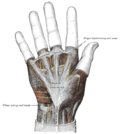Superficial palmar arch
Superficial palmar arch is an arterial network found in the palm of the hand. It is formed primarily by the ulnar artery, with a contribution from the superficial palmar branch of the radial artery. The superficial palmar arch is responsible for the blood supply to the fingers and the muscles of the little finger and ring finger.
Anatomy
The superficial palmar arch is located in the subcutaneous tissue of the palm, superficial to the long flexor tendons and the lumbrical muscles. It is covered by the palmar aponeurosis, a thick fascial layer, and the skin. The arch is formed by the ulnar artery, which enters the hand anterior to the flexor retinaculum and lateral to the pisiform bone. The superficial palmar branch of the radial artery joins the arch, completing it distally.
Branches
The branches of the superficial palmar arch include the common palmar digital arteries and the proper palmar digital arteries. The common palmar digital arteries arise from the convexity of the arch and divide into two proper palmar digital arteries. These arteries supply the medial three and a half fingers.
Clinical significance
The superficial palmar arch is important in surgical procedures involving the hand. Its location and the distribution of its branches need to be considered in surgeries such as carpal tunnel release and palmar fasciectomy. In addition, variations in the formation of the arch can have clinical implications. For example, if the arch is not completed by the radial artery, the blood supply to the fingers may be compromised.
See also
Transform your life with W8MD's budget GLP-1 injections from $125.
W8MD offers a medical weight loss program to lose weight in Philadelphia. Our physician-supervised medical weight loss provides:
- Most insurances accepted or discounted self-pay rates. We will obtain insurance prior authorizations if needed.
- Generic GLP1 weight loss injections from $125 for the starting dose.
- Also offer prescription weight loss medications including Phentermine, Qsymia, Diethylpropion, Contrave etc.
NYC weight loss doctor appointments
Start your NYC weight loss journey today at our NYC medical weight loss and Philadelphia medical weight loss clinics.
- Call 718-946-5500 to lose weight in NYC or for medical weight loss in Philadelphia 215-676-2334.
- Tags:NYC medical weight loss, Philadelphia lose weight Zepbound NYC, Budget GLP1 weight loss injections, Wegovy Philadelphia, Wegovy NYC, Philadelphia medical weight loss, Brookly weight loss and Wegovy NYC
|
WikiMD's Wellness Encyclopedia |
| Let Food Be Thy Medicine Medicine Thy Food - Hippocrates |
Medical Disclaimer: WikiMD is not a substitute for professional medical advice. The information on WikiMD is provided as an information resource only, may be incorrect, outdated or misleading, and is not to be used or relied on for any diagnostic or treatment purposes. Please consult your health care provider before making any healthcare decisions or for guidance about a specific medical condition. WikiMD expressly disclaims responsibility, and shall have no liability, for any damages, loss, injury, or liability whatsoever suffered as a result of your reliance on the information contained in this site. By visiting this site you agree to the foregoing terms and conditions, which may from time to time be changed or supplemented by WikiMD. If you do not agree to the foregoing terms and conditions, you should not enter or use this site. See full disclaimer.
Credits:Most images are courtesy of Wikimedia commons, and templates, categories Wikipedia, licensed under CC BY SA or similar.
Contributors: Prab R. Tumpati, MD









